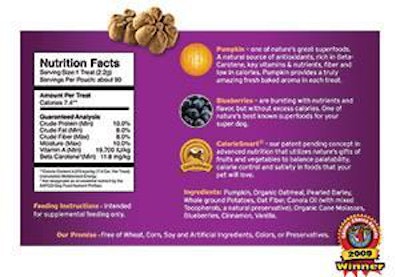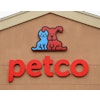
The petfood aisle is a sea of bright-colored packaging and dozens of kibble shapes. Consumers have proven that familiar "humanized" petfoods and treats are what they are after when it comes to feeding their pets. Some manufacturers may fear that promoting their food with an unfamiliar ingredient may cause consumers to reach for something more recognizable; other companies chose to take a bold approach, making the health benefits of these unusual ingredients the appeal. A few novel ingredients aren't necessarily foreign to consumers, but they may not expect to find them in their pet's bowl.
If the pomegranate was 2009's most talked about superfood, the blueberry is set to claim the position for 2010. Recently, Health magazine named blueberries high on its list of "America's Healthiest Superfoods." The feature, running in the magazine's January/February 2010 issue, singled out blueberries' impressive variety of potential health benefits, including preventing memory loss, improving motor skills, lowering blood pressure, and fighting age.
A native North American berry, blueberries grow abundantly in Maine and Canada. Blueberries have been found to have a higher level of antioxidants than most other fruits by USDA research findings and by such publications as the Journal of Agriculture and Food Chemistry . When Tufts University researchers at the USDA Human Nutrition Research Center on Aging reviewed disease-fighting antioxidant activity of 40 fruits and vegetables, blueberries beat the pack by a wide margin. Study results indicated that the benefits of eating just one serving of blueberries equaled those of eating two to three servings of other fruits and vegetables, such as spinach, apples, and broccoli.
Blueberries are already being utilized in several petfoods and treats distributed in North America, such as Fruitables Pumpkin and Blueberry Treats for Dogs and FirstMate Pet Food Chicken with Blueberries Dog Food. According to Fruitables, blueberries are a good source of dietary fiber for dogs and can help aid in digestion.
Perhaps the next novel ingredient isn't something as easily recognized by consumers as a blueberry, but an ingredient who's health benefits are just as easy to notice. According to Dr. Anton C. Beynen of Vobra Special Petfoods BV and Pauline Paap of Orffa Additives, those super ingredients may very well be beta-1,3/1,6-glucans.
What exactly are beta-glucans? Beta-1,3/1,6-glucans are polymers of glucose with glucose molecules linked together by beta-1,3-bonds and 'branches' of glucose molecules through beta-1,6-linkages, Dr. Beynen and Ms. Papp explain. These glucans can be isolated from the cell walls of baker's yeast ( Saccharomyces cerevisiae ).
Research in pigs has demonstrated that the feeding of beta-1,3/1,6-glucans reduced the plasma concentrations of pro-inflammatory cytokines and raised that of an anti-inflammatory cytokine. Researchers speculate that the intake of beta-1,3/1,6-glucans may reduce inflammation in canine and feline disorders such as osteoarthritis, atopy and inflammatory bowel disease. The effect of ingested beta-1,3/1,6-glucans on cytokine production may also inhibit the degradation of cartilage collagen which would be an additional advantage in the treatment of canine osteoarthritis.
According to Beynen and Papp's abstract Beta-1,3/1,6-glucans as functional ingredient for petfoods , in a double-blind, placebo-controlled trial with privately owned, osteoarthritic dogs the test dogs were fed on a complete dry food with 800 ppm beta-1,3/1,6-glucans; as a placebo, the same diet without supplement was used. When compared with the placebo treatment, the ingestion of beta-1,3/1,6-glucans showed a greater improvement as to the scores for activity, stiffness, lameness and pain.
In a separate study, it was found that the intake of purified beta-1,3/1,6-glucans improved the clinical signs of dogs with chronic skin disorders. "Given the anti-inflammatory action of beta-1,3/1,6-glucans, it would be anticipated that atopy in dogs and cats may be managed by feeding a diet containing the functional ingredient," conclude Benyen and Papp.
Although beta-glucans and superfood berries may add something extra to a petfood formula, a key component in both canine and feline diets is the protein source. "Today´s petfood industry is growing rapidly with pet owners demanding high-quality diets for their pets," say Franz-Peter Rebafka and Ashish Kulshrestha of GePro Gefluegel-Protein. "This demand creates a search for alternative protein sources that may be included into diets to meet the amino acid requirements of the pets. As costs for animal proteins increases and availability decreases, processed by-products have become an important primary protein source for the industry."
Figure 1: Crude protein digestibility of petfood
Rebafka and Kushrestha propose that hydrolyzed, poultry-based proteins - in other words, hydrolyzed feather meal - are economically interesting protein sources already being used in specific areas of the feed business like aquaculture, so why not in petfoods? While these proteins are economically interesting and free of anti-nutritional factors, the use of (processed) feather meal in petfood has been limited for reasons such as poor digestibility and issues related to marketing - particularly in areas like ingredients declaration.
Several factors are known to modify digestibility of protein and amino acids, however. Among the process conditions, the drying conditions seem to play a major role in respect to digestibility and nutritional quality of hydrolyzed feather meal. Realizing the beneficial effects of a lower temperature (LT) fishmeal drying system, a new product - GoldMehl LT feather meal specifically for petfood - has recently been launched. In a feeding trial conducted at Ideopet Pet Panel, it could be demonstrated that LT feather meal had no negative impact on palatability (no food refusals during the trial were recorded). All diets reached high dry matter digestibility above 85% comparable to other premium dry petfoods. Researchers concluded that in dogs LT feather meal has feeding values similar to that of poultry meal.
Biological value (BV) of proteins is another key aspect of petfood nutrition that must be considered. Although utilizing goat's milk protein in dog foods may sound like a new idea, many manufacturers seeking to develop nutritious and wholesome foods have successfully created such products. Mt. Capra Wholefood Nutritionals is currently the largest goat's milk protein manufacturer in the country. Mt. Capra says Caprotein is an ideal powder additive for products appealing to health-conscious consumers. Caprotein is described as "a premium quality goat-milk protein powder providing a balanced combination of whey protein and milk protein." The product contains all amino acids essential for optimal health, according to the company. Caprotein is lacto-fermented to assist digestion and absorption while delivering beneficial probiotics and enzymes.















